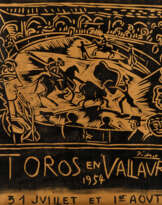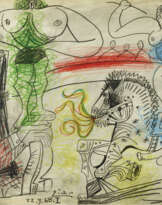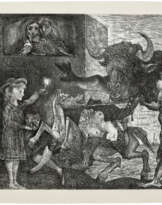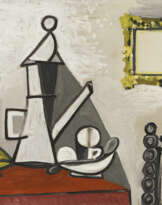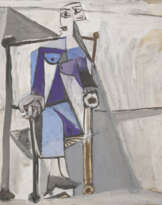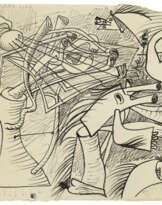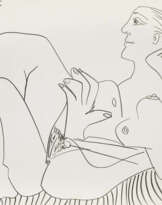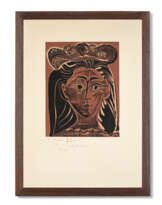ID 952172
Lot 50 | Pablo Picasso (1881 Malaga - 1973 Mougins) (F)
Valeur estimée
€ 8 000 – 12 000
'Spanish pitcher', weißes Steingut, polychrom staffiert, Maße 18 cm x 12 cm x 26 cm, unterseitig 'EDITION PICASSO 139/200 MADOURA' bezeichnet und nummeriert, 'MADOURA PLEIN FEU' und 'EDITION PICASSO' gestempelt, partiell minimal fleckig, unterseitig berieben, Literatur: Wvz. Ramié 244, mit farb. Abb.
Pablo Picasso gilt als einer der bedeutendsten Künstler des 20. Jahrhunderts. Sein umfangreiches Oeuvre beinhaltet ebenso Gemälde, Zeichnungen, Skulpturen wie Grafiken, Literatur und Keramik. Zu Lebzeiten hat er seine nahestehenden Künstlerkollegen sicherlich ebenso beeinflusst, wie sie ihn - zumal er mit einigen Kollegen im berühmten Pariser Bateau-Lavoir lebte und dessen Ateliers mit ihnen teilte. So hat er mit George Braque den Kubismus erarbeitet, sowie seine bekanntesten Werke Guernica und die Demoiselles d'Avignon geschaffen. Neben diesen weltbekannten Kunstwerken sind die rund 3000 Keramiken, die Picasso anfertigte, zwar kaum bekannt, doch nicht weniger bedeutend. Entstanden sind diese Keramiken gleichermaßen in einem ebenso kreativen und geradezu experimentellen Prozess, wie er zu seinen Skulpturen und Gemälden verfolgte. Die Keramiken Picassos sind nicht nur ein Nebenprodukt seiner künstlerischen Tätigkeit, sondern eine künstlerische Möglichkeit seiner Kreativität weitere Ausdrucksmöglichkeiten zu bieten. Angefertigt wurde ein enormes Gesamtwerk, mit dem er das bestehende Kunstsystem herausfordern und überwinden wollte. Denn durch die Mischung aus Gebrauchsgegenstand und Kunstwerk hat er einen Weg finden können die Kunst nicht etwa zu glorifizieren, sondern sie in das alltägliche Leben einfließen zu lassen. Picasso wollte seine Kunst einem breiten Publikum zugänglich machen. Seine Keramiken und vor allem die Serienauflagen ermöglichten ihm, dieses Ziel zu erreichen: durch die Form der Gebrauchskeramik. Während einer Töpferausstellung traf der Künstler Suzanne und Georges Ramie, die Eigentümer der Keramikwerkstatt Madoura. Picasso unternahm seine ersten Versuche mit Keramik. Er nutzte Ton, schuf Faune und Nymphen, dekorierte Platten und Teller mit seinen bevorzugten Motiven wie den Stierkampf, Frauen, Eulen, Ziegen, benutzte ungewöhnliche Unterlagen und entwickelte selbst eine weiße Tonmasse. Immer wieder ist in seinen Keramiken zu erkennen, wie eng verwurzelt Picasso mit der jahrtausendealten Geschichte der Keramik war. Von klassischen griechischen Vasen mit roten und schwarzen Figuren über die etruskischen Buccheri, den Tongefäßen der prähispanischen Kulturen bis zur volkstümlichen Keramik aus Spanien und Frankreich. Picasso kannte die zahlreichen im Louvre in Paris ausgestellten Keramikobjekte der antiken Mittelmeerkulturen, besaß viele Bücher zu antiker Kunst und bezog seine Inspirationen - sowohl hinsichtlich der Formen als auch der Themen eines Großteils seiner Keramiken - aus Gefäßen mit menschlichen oder tierischen Formen. Der Künstler schuf sogar fiktive "antike" Keramiken und bemalte archäologische Keramikfragmente. Als ganz wesentlich ist an dieser Stelle anzumerken, dass Picassos Keramiken sich nicht nur auf die Traditionen dieser Kunstform beziehen, sondern auch auf seinen eigenen Werdegang als Künstler. Durch verschiedene Keramiken wird deutlich, wie er seine gestalterischen Erfahrungen als Maler, Graveur und Bildhauer und die entsprechenden Motive seiner Gemälde, Lithografien und Zeichnungen auch in der Ausformung und Bemalung des Steinzeugs verwendet. Ebenso nutzt er seine neu gewonnenen Erfahrungen aus dieser Arbeit für Kunstwerke malerischer Form. Somit erneuerte er auch das eigens geschaffene Motiv der Taube, das er 1949 als Plakat für den Pariser Weltfriedenskongress entwarf, welches bis heute als weltweites Friedenssymbol gilt.
Pablo Picasso (1881 Malaga - 1973 Mougins) (F)
'Spanish pitcher', white stoneware, polychrome painted, dimensions 18 cm x 12 cm x 26 cm, on the reverse EDITION PICASSO 139/200 MADOURA inscribed and numbered, MADOURA PLEIN FEU and EDITION PICASSO stamped, partially minimally stained, rubbed on the reverse side, Literature: Cat. Rais. Ramié 244, with colour ill.
Pablo Picasso is considered one of the most important artists of the 20th century. His extensive oeuvre includes paintings, drawings, sculptures, graphics, literature and ceramics. During his lifetime, he certainly influenced his close artist colleagues as much as they influenced him - especially since he lived with some colleagues in the famous Parisian Bateau-Lavoir and shared its studios with them. He thus worked on Cubism with George Braque, as well as creating his most famous works Guernica and the Demoiselles d'Avignon. In addition to these world-famous works of art, the 3000 or so ceramics that Picasso made are little known, but no less important. These ceramics were created in an equally creative and almost experimental process as he pursued for his sculptures and paintings. Picasso's ceramics are not just a by-product of his artistic activity, but an artistic opportunity to offer his creativity further possibilities of expression. An enormous body of work was produced with which he wanted to challenge and overcome the existing art system. For by mixing utilitarian objects and works of art, he was able to find a way not to glorify art, but to let it flow into everyday life. Picasso wanted to make his art accessible to a broad public. His ceramics and especially the serial editions enabled him to achieve this goal: through the form of utilitarian ceramics. During a pottery exhibition, the artist met Suzanne and Georges Ramie, the owners of the Madoura ceramics workshop. Picasso made his first experiments with ceramics. He used clay, created fauns and nymphs, decorated plates and platters with his favourite motifs such as the bullfight, women, owls, goats, used unusual supports and developed a white clay mass himself. Time and again, his ceramics reveal how closely Picasso was rooted in the millennia-old history of ceramics. From classical Greek vases with red and black figures to the Etruscan buccheri, the clay vessels of the pre-Hispanic cultures and the popular ceramics from Spain and France. Picasso was familiar with the numerous ceramic objects of the ancient Mediterranean cultures exhibited in the Louvre in Paris, owned many books on ancient art and drew his inspiration - both in terms of the forms and the themes of a large part of his ceramics - from vessels with human or animal forms. The artist even created fictitious "ancient" ceramics and painted archaeological ceramic fragments. It is essential to note at this point that Picasso's ceramics not only refer to the traditions of this art form, but also to his own development as an artist. Through various ceramics, it becomes clear how he uses his creative experiences as a painter, engraver and sculptor and the corresponding motifs of his paintings, lithographs and drawings in the shaping and painting of the stoneware. Likewise, he used his newly gained experience from this work for works of art in painterly form. Thus, he also renewed the specially created motif of the dove, which he designed as a poster for the Paris World Peace Congress in 1949 and which is still considered a worldwide symbol of peace today.
| Artiste: | Pablo Picasso (1881 - 1973) |
|---|---|
| Catégorie maison de vente aux enchères: | Céramique, Faïence |
| Artiste: | Pablo Picasso (1881 - 1973) |
|---|---|
| Catégorie maison de vente aux enchères: | Céramique, Faïence |
| Adresse de l'enchère |
WETTMANN Luxusuhren Bredeneyer Straße 119-121 45133 Essen Allemagne | ||||||||||||||
|---|---|---|---|---|---|---|---|---|---|---|---|---|---|---|---|
| Aperçu |
| ||||||||||||||
| Téléphone | +4920185785190 | ||||||||||||||
| Fax | +49 (0)208 439 17 35 | ||||||||||||||
| Commission | 14,28% | ||||||||||||||
| Conditions d'utilisation | Conditions d'utilisation | ||||||||||||||
| transport |
Service postal Service de messagerie ramassage par vous-même | ||||||||||||||
| Modes de paiement |
Virement bancaire | ||||||||||||||
| Heures d'ouverture | Heures d'ouverture
|







